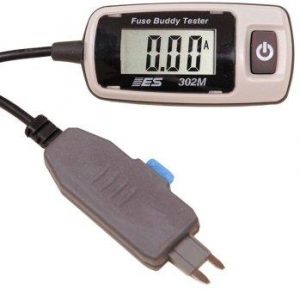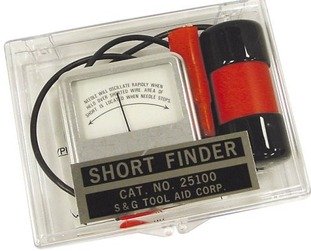
When it comes to blown fuses how you find the root cause and the way it’s repaired is handled about the same on a 57 Chevy and a 2003 Chevrolet Malibu. Regardless of the model year, it’s a sign of electrical problems. Owners and mechanics will often replace the fuse without looking any further into why it happened.
This page talks about why and how to logically investigate for the root cause of the malfunction. The vehicle manufacturer sets the fuse amperage value at more than double what the circuit would normally carry.
If a fuse blows in a circuit, you can almost guarantee that even if the problem is intermittent you’ll see the same fuse fail again. I added a video below walking you through the procedure I use to hunt down electrical shorts. This isn’t the only thing that will blow an automotive fuse but it’s a common cause.

I purchased the fuse buddy product from Amazon. It is handy for solving intermittent fuse problems. It can check circuit amperage draw by plugging into the fuse panel.
This way you can look for surges in current draw from components such as motors and solenoids. It works with both ATC and mini fuses. Let me give you a specific example to prove my point that digging in a little further can prevent repeat visits for fuse replacement.
This specific example is something you may find if you happen to be working on a GM or Chevrolet vehicle from the mid-90s. The fleet that I work for operates for the most part late-model Chevrolet, Ford and Dodge pickup trucks.
The fleet does have a few cars and except for a couple of hybrid test vehicles all are domestic. In the fleet are a few 1995 Chevrolet 1500 series pickups with about 40,000 miles on them. They continue to operate in the fleet due to budget restrictions.
Automotive Fuses Keep Blowing
 The drivers of these light duty trucks were complaining about intermittent air conditioning operation. Upon initial inspection of the vehicle we were finding blown AC fuses.
The drivers of these light duty trucks were complaining about intermittent air conditioning operation. Upon initial inspection of the vehicle we were finding blown AC fuses.
At first we were just popping in a new fuse and releasing the vehicle to continue its workday. But eventually we had to dig in and find out what was causing this problem. Searching down an intermittent short can be extremely time-consuming and a real headache. I decided to take a look for some TSB’s related to the blown AC fuse problem. Surprise, I found one.
The technical service bulletin explained that the AC wiring harness that runs on the underside of the dash board was known to chafe in two areas. This caused an intermittent short circuit, which in turn was taking out the fuse. The service bulletin showed pictures of exactly where the wiring harnesses chaffed on the sharp edge of a bracket.
So the root cause was the AC blower motor power wire lightly rubbing up against the radio support bracket for the last 10 years. This eventually caused a bare spot on the wire insulation and the radio support bracket was grounded, causing a power to ground short circuit. The technical bulletin also described how the wire could rub against the ashtray bracket and we did see this as well.
How to Repair Blown Fuses

There are several approved methods to repair this type of short circuit problem. In my case, I cut out the damaged part of the wire and just replaced it with but connectors on either side.
A lot of people don’t like butt connectors. I did use the specialized heat shrink connectors that keeps moisture out of the repair. Another reason that this quick repair is okay, is the AC circuit is just a standard 12 volt electrical circuit.
If this were a 5 Volt reference circuit for the computer or oxygen sensor wiring that operates on low voltage then I would have used a different method of repair. Maybe even a copper crimp and some rosin core electrical solder covered with some shrink wrap.
The most important part of this repair was to relocate the air-conditioning wiring harness to a safe location so that it would not rub against any grounded objects meaning no more blown fuses. Two things to learn from this story are, 1) if you have an open fuse take a look at what circuit the fuse supplies, and then search for the electrical problem that caused it.
The second lesson learned is that if you have a particular fuse that continues to blow this may be a failure that others are experiencing. Technical service bulletins can save you a lot of time and direct you to exactly what needs fixing.
Video on Finding Electrical Shorts

Do you need help right now with specific automotive problems? Dig in to my electrical section for more information and training in this area. This next link takes you to the automotive electrical help start page.

